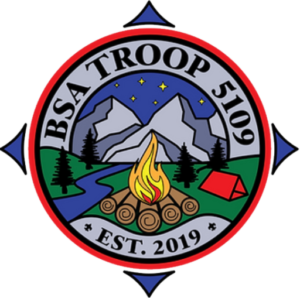Advancement Resources
Find many of the most needed documents and resources for Scouts and Families
Scout Advancement
Part of the scouting journey is advancement. Scouts advance by undertaking a variety of activities and challenges to broaden their skills, knowledge, and love of adventure. While the rank of Eagle is the highest a Scout can earn, they must first advance through seven other ranks. Each rank’s requirements are detailed on the pages below. Part of each rank, after Scout rank, is a Board of Review. Details about what happens during a Boards of Review including sample questions can be found here.
Scout
Scout was previously a joining badge, but is now considered the first rank, and is earned by completing certain requirements. As of January 2016, the Scout badge has a gold fleur-de-lis on a tan background. The badge is awarded when the youth demonstrates a rudimentary knowledge of Scouting skills and ideals such as tying a square knot and knowing the Scout oath, law, motto, and slogan.
Tenderfoot
Tenderfoot is the second rank a Scout can earn. A Scout can work on the requirements for the Tenderfoot, Second Class, and First Class ranks at the same time, but each rank must be earned in sequence. The badge is awarded when the Scout completes requirements in the areas of Scoutcraft, physical fitness, citizenship, personal growth, and Scout Spirit. The badge is similar to that of the Scout rank with it adding an eagle and two stars.
Second Class
Second Class is the rank above Tenderfoot and below First Class. A Scout can work on the requirements for the Tenderfoot, Second Class, and First Class ranks at the same time, but must be earned in sequence. The badge is awarded when the Scout completes requirements in the areas of Scoutcraft, physical fitness, citizenship, personal growth and Scout Spirit
First Class
First Class is the rank above Second Class and below Star Scout. A Scout can work on the requirements for the Tenderfoot, Second Class, and First Class ranks at the same time, but must earn them in sequence. The badge is awarded when the Scout completes requirements in the areas of Scoutcraft, physical fitness, citizenship, personal growth and Scout Spirit. At this point, Scouts shift focus from learning physical Scouting method to start developing leadership skills.
Star
Star is the rank above First Class and below Life Scout. It is the third-highest rank. Star is awarded when the Scout serves actively in the troop, team or crew in a position of responsibility for at least 4 months; performs at least six hours of community service; and earns six merit badges (four of which must be among the 13 required for Eagle Scout rank).
Life
Life is the second-highest rank attainable, above Star and below Eagle. Life is awarded when the Scout serves actively in the troop, team or crew, serves in a position of responsibility for six months, and performs six hours of community service.[6] A Scout must also earn five merit badges (at least three of which must be required for the rank of Eagle) for a total of 11, including the six previously earned. Finally, the Scout must pass a Scoutmaster conference, and board of review.
Eagle
Eagle Scout is the highest rank attainable in the Scouts BSA division of the Boy Scouts of America.
Requirements include earning a minimum total of 21 merit badges, including all required badges that were not previously earned, and demonstration of Scout Spirit, service and leadership. This includes an extensive service project that the Scout plans, organizes, leads, and manages.
Eagle Palms
Eagle Palms are bronze, gold and silver awards presented to young men and women who earn five, 10, 15 or more merit badges beyond the 21 required to become an Eagle Scout. Merit badges earned at any time since becoming a registered Scouts BSA member may be used.
